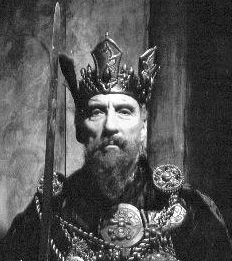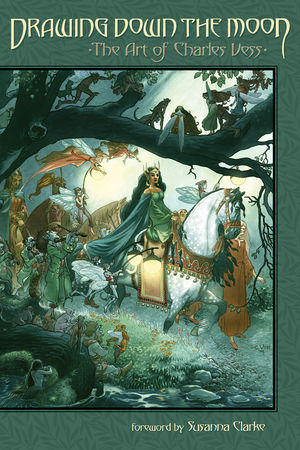Wednesday, January 20, 2010
posted by Deuce Richardson
 “…the older Christopher Lee gets, the cooler Christopher Lee gets.”
“…the older Christopher Lee gets, the cooler Christopher Lee gets.”
— Steve Tompkins, “The Voice of Saruman, Speaking the First Age Into Being”
While I’d heard whispers of a new Christopher Lee project on the Official Robert E. Howard Forum,* it was this fine blog entry by Jeff Sypeck on the Quid Plura? site which motivated me to get up off the parliamentary side o’ me arse and compose a blog entry of my own.
(Continue reading this post)
Monday, January 4, 2010
posted by Deuce Richardson

James Maliszewski
Yesterday, James Maliszewski, proprieter of the Grognardia website, as well as a Friend of the Cimmerian, wrote up a thoughtful birthday post regarding Tollers. Primarily, the entry is concerned with the influence of the appendices for The Lord of the Rings upon James’ early role-playing gaming career. It’s a worthy piece and I advise the RPG-inclined to check it out.
However, while not exactly a quibble, I think it worth mentioning that Tolkien did not in reality “box in” or over-explicate his sub-creation of Middle-earth as much as some surmise. If one excludes The Silmarillion and considers only The Hobbit and The Lord of the Rings, then JRRT left vast areas of his world unexplored and saw fit to let many metaphysical questions remain unanswered. The only region given a thorough going-over was north-western Middle-earth and even that had large areas about which little was revealed, whether in the tales themselves or in the appendices.
In contrast, Robert E. Howard had Conan personally visit many more far-flung regions (though it appears Aragorn came close to matching the Cimmerian in his own wanderings). In Howard’s (barely) post-Hyborian Age yarn, “Marchers of Valhalla,” he had Hialmar’s Æsir war-band nearly circumnavigate the globe on foot. In addition, while no official ‘appendix,’ REH’s “The Hyborian Age” essay goes a long way towards fulfilling that function.
Just something that occurred to me.
Saturday, November 21, 2009
posted by Deuce Richardson

James Maliszewski, the proprietor of Grognardia and a Friend of The Cimmerian, has posted an article on The Escapist website. It is called “The Books That Founded D&D” and I found it quite interesting. I thought it worth some commentary.
Mr. Maliszewski starts his essay noting the various reasons why J.R.R. Tolkien should be dismissed as major influence upon the role-playing game that Gygax and Arneson developed. Most of the evidence used to back this up is cited from Gygax’s own writings. The fact that these writings date from before and after the threatened lawsuit by Tolkien Enterprises means very little, in my view.
Tolkien deeply influenced Dungeons and Dragons. That is my humble opinion and I stand by it. The Elves as portrayed in D&D would be far different if JRRT had never written his novel, The Lord of the Rings. The same for D&D dwarves. Double ditto for “orcs,” which species (with that particular appellation) would never exist, but for Tollers. Triple ditto for the “halflings” in the game (whom I always considered ridiculous, in game terms). All of that, however, is fodder for another blog entry. Now, let’s get to all the stuff that James Maliszkewski and I do agree on (more or less)…
(Continue reading this post)
Tuesday, November 17, 2009
posted by Deuce Richardson

Andy Serkis, the actor whose voice and mannerisms brought to life the character of Gollum in Peter Jackson’s film adaptation of Lord of the Rings, has now taken on another unsavory character sprung from the well of imagination that was the Inklings. This time, Serkis is trying his hand at Screwtape, the epistolary demon from C.S. Lewis’ classic, The Screwtape Letters (which book was dedicated to JRRT).
(Continue reading this post)
Tuesday, November 10, 2009
posted by Deuce Richardson

After my Tolkien post last Saturday, several interesting new insights have come to light. Wayne Hammond and Christina Scull, authors of The J.R.R. Tolkien Companion and Guide, posted this response to the Daily Telegraph article over on the J.R.R. Tolkien Collector’s Guide forum:
(Continue reading this post)
Saturday, November 7, 2009
posted by Deuce Richardson

If one judged by recent posts, it might be hard to tell that The Cimmerian is a “website and shieldwall” for Robert E. Howard and J.R.R. Tolkien. The Man From Cross Plains has dominated our recent blog activity, but never think we’ve forgotten Tollers. The Cimmerian will be giving the Loremaster of Middle-earth his due in the coming weeks and months. I stumbled upon a couple of news items relating to John Ronald Reuel yesterday. While both concerned revelations that are weeks old (at least), I hadn’t known about either of them and I assume that both articles would be news to many others.
(Continue reading this post)
Thursday, October 8, 2009
posted by Deuce Richardson

Dark Horse Comics just announced that, in honor of their imminent publication of Drawing Down the Moon by Charles Vess, they are offering the entire book online for free viewing for an indefinite time.
(Continue reading this post)
Friday, September 25, 2009
posted by Deuce Richardson
One of the most significant archaeological discoveries ever made on British soil was announced this week. The news? An amateur treasure-hunter in western Staffordshire recently discovered an Anglo-Saxon hoard of unprecedented size and richness. The location of the “Staffordshire hoard” (dated to the half-century betwixt 675 and 725AD) places it within the north-western boundaries of the Dark Age Saxon kingdom of Mercia.
J.R.R. Tolkien was deeply interested in the history of Mercia. He traced his maternal (and much of his paternal) line back to that realm. Tolkien spent almost all of his childhood within the bounds of the now-vanished kingdom. He is known to have stated that he felt a sense of instant familiarity and kinship with the distinctive Mercian dialect of Old English when he first encountered it, early on in his philological studies. A good deal of The Book of Lost Tales was localized within what was Mercian territory. He even seems to have believed that Beowulf, possibly the one work of literature closest to his heart, was composed in Mercia at roughly the time that the “Staffordshire hoard” seems to have been inhumed.
Mercia itself ought to be known in some degree by anyone who is familiar with Tolkien’s legendarium. It can be seen, in a very fantasticated form (in much the same way that REH’s envisioning of medieval Ireland resembles Hyborian Age Cimmeria) in The Lord of the Rings. Namely, Rohan; or, as the Eorlingas themselves called it: the Riddermark. Riddermark. “The ‘Mark’ of the Horsemen.” The word “mark” in this instance is derived by JRRT from the Anglo-Saxon word “mearc” (the basis, ultimately, for the name, “Mercia”) which is itself sprung from an even older term for “line or boundary.” By linguistic extension, that noun in Anglo-Saxon came to mean “border” or “frontier” (though only its more common and primal sense survived into modern English). Words such as “marquis,” “Denmark” and “march” (as in the sense of a “Bossonian March”) fossilize this archaic meaning like ancient beasts in amber.

(Continue reading this post)
Wednesday, June 24, 2009
posted by Deuce Richardson
 It was almost two years ago to the day that I first learned of the (then) forthcoming audiobook dedicated to The Children of Húrin. Despite the heads-up from Mr. Tompkins, it was only in the waning days of May 2009 that I finally acquired my own copy. Having some unforeseen time on my hands this last week, and an anniversary to commemorate, I sat back and gave a listen to Christopher Lee’s (and Christopher Tolkien’s) performance on the night of June 22, 2009.
It was almost two years ago to the day that I first learned of the (then) forthcoming audiobook dedicated to The Children of Húrin. Despite the heads-up from Mr. Tompkins, it was only in the waning days of May 2009 that I finally acquired my own copy. Having some unforeseen time on my hands this last week, and an anniversary to commemorate, I sat back and gave a listen to Christopher Lee’s (and Christopher Tolkien’s) performance on the night of June 22, 2009.
I purchased my copy of The Children of Húrin audiobook for twenty-five dollars and received it still in its cellophane coll, pristine as driven snow. HarperCollins cut no corners with this production. The eight compact discs are sturdily packaged in an attractive box (though, agreeing with others, I find the Alan Lee rendition of Túrin to be underwhelming). Nestled snugly within the box are two CD cases, each of which contain four compact discs. Within the first case is a booklet containing a complete table of contents pertaining to all eight discs. The booklet also presents plates by Alan Lee for the print edition. The second CD case contains an excellent reproduction of Christopher Tolkien’s map of Beleriand. The covers for both cases are derived from Alan Lee’s The Children of Húrin calendar, paintings not found in the print version. All in all, a sumptuous package. (Continue reading this post)
Wednesday, June 17, 2009
posted by Deuce Richardson
“But upon all whom you love my thought shall weigh as a cloud of Doom, and it shall bring them down into darkness and despair. Wherever they go, evil shall arise. Whenever they speak, their words shall bring ill-counsel. Whatsoever they do shall turn against them. They shall die without hope, cursing both life and death.”
Morgoth’s words to Húrin, son of Galdor, upon the Haudh-en-Nirnaeth, from The Children of Húrin by J.R.R. Tolkien.
In my first post about Húrin, the greatest mortal warrior of Tolkien’s First Age, I looked at his life and deeds up to his sixtieth year. In my follow-up blog, I then summarized the events laid out in the collection of texts which JRRT seems to have intended to call “The Wanderings of Húrin.” In this post, I will trace Húrin’s journey to its bitter end. Much of this is recounted in The Silmarillion, but significant bits of the tale can only be found in The War of the Jewels: The Later Silmarillion.
(Continue reading this post)
 “…the older Christopher Lee gets, the cooler Christopher Lee gets.”
“…the older Christopher Lee gets, the cooler Christopher Lee gets.”







 It was almost
It was almost 


